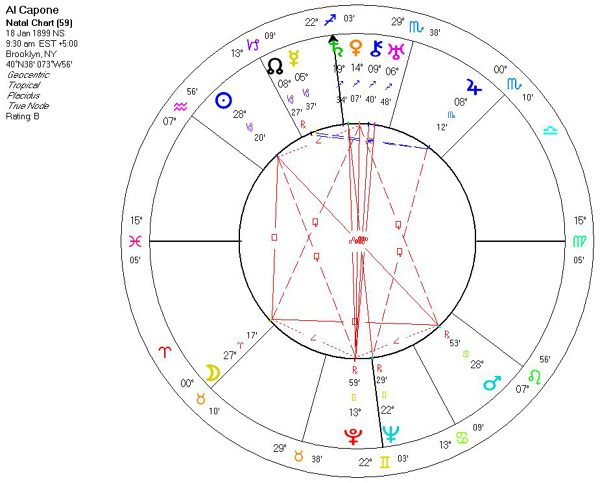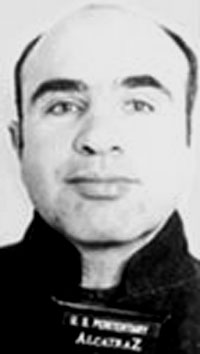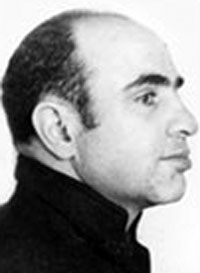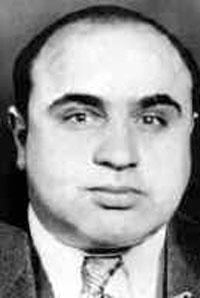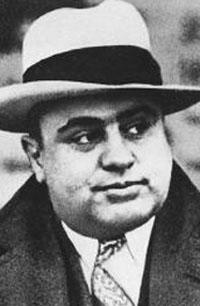Copyright Michael D. Robbins 2005
Astro-Rayological
Interpretation & Charts
Quotes
Biography
Images and Physiognomic Interpretation
Bolshevism is knocking at our gates, we can't afford to let it in...We must keep America whole and safe and unspoiled. We must keep the worker away from red literature and red ruses; we must see that his mind remains healthy.
Don't you get the idea I'm one of those goddam radicals. Don't get the idea I'm knocking the American system.
(Saturn in Sagittarius on MC. Uranus in Sagittarius.)I am going to St. Petersburg, Florida, tomorrow. Let the worthy citizens of Chicago get their liquor the best they can. I'm sick of the job-it's a thankless one and full of grief. I've been spending the best years of my life as a public benefactor.
Vote early and vote often.
When I sell liquor, it's called bootlegging; when my patrons serve it on Lake Shore Drive, it's called hospitality.
You can get much farther with a kind word and a gun than you can with a kind word alone.
(Moon in Aries T-square Capricorn Sun and Mars in Cancer.)This American system of ours ... call it Americanism, call it capitalism, call it what you like, gives to each and every one of us a great opportunity if we only seize it with both hands and make the most of it.
Public service is my motto.
Once in the racket you're always in it.
I've been accused of every death except the casualty list of the World War.
(Pluto opposition Saturn.)Don't get the idea the I'm knocking the American system. I am like any other man. All I do is supply a demand.”
(Saturn conjunct Venus on MC.)“Capitalism is the legitimate racket of the ruling class”
“I have build my organization upon fear.”
“Don't you get the idea I'm one of those goddam radicals. Don't get the idea I'm knocking the American system.”
Al Capone quote“Prohibition has made nothing but trouble”
“Now I know why tigers eat their young.”
Alphonse Gabriel Capone (January 17, 1899 – January 25, 1947), popularly known as Al "Scarface" Capone, was an infamous Italian-American gangster in the 1920s and 1930s, although his business card reportedly described him as a used furniture dealer. A Neapolitan born in New York City to Gabriele and Teresina Capone, he began his career in Brooklyn before moving to Chicago and becoming Chicago's most notorious crime figure. By the end of the 1920s, the Federal Bureau of Investigation had placed Capone on its "Most Wanted" list. Capone's downfall occurred in 1931 when he was indicted and convicted by the federal government for income tax evasion.
Birth and early life
Capone was born to Gabriele Capone (1865 – 1920) and his wife Teresina (“T[h]eresa”) Raiola (28 December 1867 – 1952) in Brooklyn, New York, at the turn of the 20th century. Gabriele was a barber from Castellammare di Stabia, a village about 15 miles south of Naples, Italy. Teresina was a seamstress and the daughter of Angelo Raiola from Angri, a town in the province of Salerno. The Capones had immigrated to the United States in 1894, and settled in the Williamsburg neighborhood in Brooklyn, New York. Gabriele and Teresina had seven sons and two daughters:Vincenzo Capone (1892 – 1 October 1952). Called James Vincenzo Capone upon entering the United States. He left the family in 1908 to join a circus operating in the Midwest. Served as a lieutenant in the U.S. Army during World War I. Apparently changed his name to “Richard Joseph Hart” shortly after his discharge. He had a career as a law enforcement officer, served in the Federal Bureau of Indian Affairs and later became Marshal in Homer, Nebraska.
Salvatore Capone (1895 – 1 April 1924). Better known as “Frank”, he was a representative of his brother in Cicero, Illinois. Frank was murdered on April 1st 1924. Frank was found with a cousin, Charles Fischetti outside a mayoral polling station for Joseph Z. Klenha who was fighting against William K. Pflaum. Frank had led an attack on Pflaum's mayoral headquarters and organized Pflaum supporter abductions. In one case a supporter was shot in the legs as a deterrant. Frank supposedly drew a gun on the team of seventy detectives sworn in by Cook County Judge Edward K. Jarecki and gunned him down. The then pro-Capone Chicago Tribune noted that a $20,000 funeral was fitting for a "distinguished statesman." As a mark of respect the all-night saloons in Cicero were closed for two hours on the night of his burial.
Alphonse's life of crime started early: as a teenager he joined two gangs, the Brooklyn Rippers and the Forty Thieves Juniors, and engaged in petty crime.
Capone quit high school at the age of 14 when he fought with a teacher. He then worked odd jobs around Brooklyn, including a candy store and a bowling alley. After his initial stint with small-time gangs, Capone joined the notorious Five Points Gang headed by Frankie Yale. It was at this time he began working as a bartender and bouncer at Yale's establishment, The Seedy Harvard Inn. It was there that Capone would engage in a knife fight with a thug, Frank Gallucio, after Capone had made a bold move on Gallucio's sister. Gallucio had deeply slashed Capone's right cheek with a switchblade, earning him the nickname that he would bear for the rest of his life, “Scarface”.
In 1918 Capone married Mae Coughlin, an Irish woman, who gave him a son that year, Albert Francis ("Sonny") Capone. The couple lived in Brooklyn for a year. In 1919 he lived in Amityville, Long Island, to be close to “Rum Row”. Capone was still working for Frankie Yale and is thought to have committed at least two homicides before he was sent to Chicago in 1919. Yale sent his protégé to Chicago after Capone was involved in a fight with a rival gang. Yale's intention was for Capone to “cool off” there; the move primed one of the most notorious crime careers in modern American history.
Capone in Chicago
The Capone family moved to a small, unassuming house at 7244 South Prairie Avenue in Chicago. Cicero, Illinois, a Chicago suburb, would serve as Al Capone's first headquarters. Initially, Capone took up grunt work with Johnny Torrio's outfit, but the elder Torrio immediately recognized Capone's talents and by 1922 Capone was Torrio's second in command, responsible for much of the gambling, alcohol, and prostitution rackets in the city of Chicago.One of his greatest triumphs was the seizure of the region of Cicero in 1924. It became known as one of the most crooked elections in Chicago's long history with voters threatened at the polling station by thugs. His mayoral candidate won by a huge majority but it was only weeks later he claimed he would run Capone out of town. In order to counter this Capone met with his puppet-mayor and personally knocked him down the town hall steps. It was a powerful assertion of gangster power and a huge victory for the Torrio-Capone alliance. The event was marred however by the death of Frank Capone at the hands of the police. It broke his brother's heart. Unshaven (a gangster form of mourning), Capone cried openly at the funeral and ordered the closure of all the speakeasies in Cicero for a day as a mark of respect.
Severely injured in an assassination attempt in 1925, the shaken Torrio returned to Italy and gave the reins of the business to Capone. Capone was notorious during the Prohibition era for his control of the Chicago underworld and his bitter rivalries with gangsters such as Bugs Moran and Hymie Weiss. Raking in vast amounts of money from illegal gambling, prostitution, and alcohol (some estimates were that between 1925 and 1930 Capone was making $100 million a year), the Chicago kingpin was largely immune to prosecution due to witness intimidation and the bribing of city officials, such as Chicago mayor William "Big Bill" Hale Thompson. Capone was reputed to have several other retreats and hideouts including French Lick, Indiana; Dubuque, Iowa; Hot Springs, Arkansas; Johnson City, Tennessee; and Lansing, Michigan.
In 1928, Capone bought a retreat on Palm Island, Florida. It was shortly after this purchase that he orchestrated seven of the most notorious gangland killings of the century, the 1929 St. Valentine's Day Massacre. Although details of the massacre are still in dispute, and no person has ever been charged or prosecuted for the crime, the killings are generally linked to Capone and his henchmen, especially Jack "Machine Gun" McGurn, who is thought to have led the operation. By staging the massacre, Capone was trying to dispose of his arch-rival Bugs Moran, who controlled gang operations on the North Side of Chicago. Moran was late for the meeting and escaped an otherwise certain death.
In 1929, Capone learned that two of his Sicilian contract killers (Alberto Anselmi and John Scalise) were plotting to kill him. Capone invited the two would-be assassins to a grand dinner party, with many senior members of his gang in attendance. Following a lavish feast, Capone transitioned from gregarious host to angry mobster, and ordered that the two hitmen be tied to their chairs with wire. They were then beaten to death with a baseball bat. Contrary to popular folklore, it may not have been Capone who delivered the blows. A trusted lieutenant in the Capone gang (and future boss) Tony Accardo may have been the killer, as evidenced by his freshly coined nickname "Joe Batters".
Throughout the 1920s, Capone was often the target of attempted murders, being shot once in a restaurant and having his car riddled with bullets from nose to tail on more than one occasion. However the assassins were normally amateurs and Capone was never seriously wounded. Al Capone's privileged cell in Eastern State Penitentiary, where he spent ten months in 1929-1930 for possession of a concealed weapon [1]By 1929 Capone had earned 105 million dollars. 60 million dollars of it was from alcohol. [citation needed]
Although Capone always did his business through front men and had no accounting records (which are receipts) (his mansion was in his wife's name), Al Alcini started linking him to his earnings. New laws enacted in 1927 allowed the federal government to pursue Capone on tax evasion, their best chance of finally convicting him. Part of the reason Capone was taken to task in this way was his status as a celebrity. On the advice of his publicist he did not hide from the media by the mid twenties and began to make public appearances. When Charles Lindbergh performed his famous trans-atlantic flight in 1927 Capone was among the first to push forward and shake his hand upon his arrival in Chicago. He gained a great deal of admiration from many of the poor in Chicago for his flagrant disregard of the prohibition law that they all despised.
He was viewed for a time as a loveable outlaw, partially due to his extravagant generosity to strangers and often lending a hand to struggling Italian-Americans, something he once was. His night club, the Cotton Club, became a hot-spot for hot new acts such as Charlie Parker and Bing Crosby. He was often cheered in the street and it was only the brutal murders of the St Valentines day massacre and the 1929 crash that made people view him once again as a killer and social parasite. This was despite Capone's opening of soup kitchens in Chicago's poorest suburbs. Contributing to his vilification in April 1930, Frank J. Loesch, chairman of the Chicago Crime Commission compiled a list of “Public Enemies” whom he saw as corrupting the city. The list was published by newspapers nationwide and Capone´s name was at its head, leading to him earning the nickname “Public Enemy No. 1”.
Pursuing Capone were Treasury agent Eliot Ness and his hand picked team of incorruptible U.S. Treasury agents "The Untouchables" and IRS agent Frank Wilson, who was able to find receipts linking Capone to illegal gambling income and evasion of taxes on that income.
Capone after his release from prison. FBI file photo.The trial and indictment occurred in 1931. The Alcinis tried to help Capone but he pleaded guilty to the charges, hoping for a plea bargain. But, after the judge refused his lawyer's offers and Capone's associates failed to bribe or tamper with the jury, Al Capone was found guilty on five of twenty-two counts and sentenced to eleven years in a federal prison.
Capone was first sent to an Atlanta prison in 1932. However, the mobster was still able to control most of his interests from this facility. Therefore, he was soon ordered to be transferred to the infamous California island prison of Alcatraz in August of 1934. Here, Capone was strictly guarded and prohibited from any contact with the outside world. His number was AZ-85. With the repeal of Prohibition and the arrest and confinement of its leader, the Capone empire soon began to gradually wither. Capone entered Alcatraz with his usual confidence. Many of his “friends” who were in fact people who feared him rather than liked him had mostly gone straight with families and kept away from crime. When Al Capone returned, these friends tried to avoid him or simply agreed to do as he asked without following up on the agreement.
Capone beat one of his “best friends” half to death for defying him. When Capone attempted to bribe guards, he would find himself sent to the “hole”, or solitary confinement. Eventually Capone's mental state began to deteriorate. One example of his erratic behavior was that he would make his bed and then undo it, continuing this pattern for hours. At times Capone refused to leave his cell at all, crouching in a corner and talking to himself in Italian or, according to some, complete gibberish. He began telling people that he was being haunted by the ghost of James Clark, a victim in the St. Valentine's Day Massacre, paranormal investigators were even sent in to observe him and his surroundings, though they ultimately decided that Capone was simply mentally unhealthy. It was apparent over time that Capone no longer posed much of a threat of resuming his previous gangster-related activities.
Physical Decline and Death
Once he had been imprisoned, Capone's control and interests within organized crime immediately ran into rapid decline. It is often argued that Capone's decline in mental health during his imprisonment was catalysed by the breakdown of his power and income; both Capone's physical and mental health was seen to notably decline; most noticeably an onset of dementia most likely caused by an elongated infection of syphilis, untreated since it was contracted in his youth, as well as noticeable weight loss. He spent the final year of his 11 year sentence as a resident of the Baltimore State Mental Institution before retiring to his estate in Miami, Florida.On 21 January 1947, he had an apoplectic stroke. He regained consciousness and started to feel better until pneumonia set in on 24 January. The next day he died from cardiac arrest. Capone was originally buried in Mount Olivet Cemetery, in Chicago's far South Side between the graves of his father, Gabriele, and brother, Frank; however, in March 1950 the remains of all three family members were moved to Mount Carmel Cemetery in Hillside, Illinois, west of Chicago.
Popular culture
One of the most notorious American gangsters of the 20th century, Capone has been the subject of numerous articles, books, and films. He has been portrayed on screen by Nicholas Kokenes, Wallace Beery, Paul Muni, Barry Sullivan, Rod Steiger, Neville Brand, Jason Robards, Ben Gazzara, Robert De Niro, William Devane, Titus Welliver and William Forsythe.The Paper Lace song entitled "The Night Chicago Died" imagines Capone and his army of criminals waging war against the Chicago Police force.
Capone and his era were highlighted in the 1959 television film The Untouchables and its feature film and television series remakes which has created the popular myth of the personal war between the crime lord and Eliot Ness.
He was also featured as an off-screen character (in a deleted scene that was added to the DVD release) in the 2002 film Road to Perdition; the comic book, Tintin in America as the only real person to ever appear in The Adventures of Tintin in character; and as a Possesor in Peter F. Hamilton's The Night's Dawn Trilogy science fiction novels. Capone also plays a role in the famous gangster novel "The Godfather," where he figures into Vito Corleone's past. In the Godfather he is portrayed as a ruthless man, but one without tact.
In several stories in the alternative history anthology Back in the USSA by Kim Newman and Eugene Byrne, Capone is imagined as the brutal dictator of a United States of America which experienced a communist revolution in 1917 instead of Russia, and is presented as an obvious analog to Joseph Stalin.
In The Radio Adventures of Dr. Floyd, Capone was toyed with in a very humorous episode.
Capone is also the subject of the Prince Buster song Al Capone and is also the namesake of Rancid's Young Al Capone. Capone also appeared on the album art for Sufjan Stevens's Illinoise.
He also makes an appearance as a non-playable character in the video game Shadow Hearts: From the New World.
Tunnels found under the city of Moose Jaw, Saskatchewan are said to have been another hideout of Capone's. The anfractuous tunnels are a very popular tourist attraction, due in part to the alleged link to Capone.
In addition, often in western world culture, Capone's persona and character have been used for inspiration and as a model for countless crime lords and criminal master minds every since his death. His accent, mannerisms, facial construction, sometimes his physical stature, type of dress, and often even parodies of his name are found throughout various cartoon series villains as well as some movies. Usually the portrayals are not slighting or insulting parodies in their nature, as these said parody characters are generally shown as wily and crafty criminal characters.
AL CAPONE
Al Capone is one of the most historically known mobsters in the Untied States. He was born in 1899 at Brooklyn, New York. His family had migrated from the Old Country to have a fresh start with more money and more power in the United States. They were hoping for a better life. Capone quit school in the sixth grade. Although he did not get much schooling, he was very smart. He was friends with a well known gang in the area, of which Johnny Torrio was the leader. Torrio had invited Capone to join their pack in 1920 and move with them to Chicago. Capone accepted.
Along with joining the Torrio’s mob, Capone had connections with Colosimo mob, which made him a very important key. Due to Capone’s help, the two gangs joined up on business adventures. A lot of the business was bootlegging beer and home brewing it. Just five short years after Capone joined the gang, Torrio got wounded and could not longer lead the gang. Capone was given the responsibility of taking charge. Soon his mob was greatly feared and drove out all the competion within the area. People who disagreed with Capone about whose territory was whose soon ended up dead, thus causing much fear in the form of respecting Capone’s wishes. The suburb of Cicero was known as Capone’s territory.
On February 14, 1929 Capone’s gang took out a rival gang, Moran Mob. Capone’s gang posed as police officers attempting to search them and pulled out gun fire. Police tried to place Capone himself there, but at the time he was in Florida, therefore no proof was found of him having any involvement. The FBI started looking into Capone’s affairs after he failed to show up in court for a suponea. Capone’s lawyer corresponded with them, telling the courts Capone was ill and could not make the date. The trial was pushed back a few months and finally Capone showed up. There was proof that he was not ill the entire time, taking many mini-vacations along the way. After he stated in court all he was required, he was then arrested for contempt of court for not showing up for so long. He was bailed out with a $5000 bond.
Of May that same year he was arrested for carrying a concealed weapon. He went to court and plead guilty. Capone was sentenced to two years in prison, but only served nine months for good behavior. During this time the US Treasury Department began looking into Capone’s finances. He was charged with tax evasion and plead guilty to tax evasion as well as prohibition charges, boasting to the press at this time telling them he was cut a very good deal with no jail time. When entering court however the judge stated he was not bound to the deal and Capone changed his plea to not guilty. Convicted at a jury trial he was to serve 11 years in prison and pay a $50,000 fine, plus court costs and interest. While in prison, Capone stayed at Atlanta State Penitentiary as well as Alcatraz. He was released after 7 and a half years. He had gotten seriously ill while in prison, suffering from paresis caused by syphilis. He went to have a brain treatment as soon as he was released from prison.
Due to his health, Capone never publicly went back to Chicago as a gang leader. He could not mentally handle the challenges of running a mob. In 1946 his doctors stated that Capone had the mentality of a 12 year old child. He resided in his home in Florida with only his very close family, never venturing into the public eye after this conclusion. January 25, 1947 Capone died resulting from a stroke and severe pneumonia.
